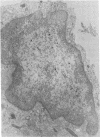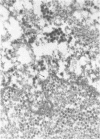Abstract
The immunoperoxidase technique was used in an electron microscopy study to localize the virions of herpes zoster virus and simian virus 40 in cell cultures. Intranuclear and intracytoplasmic virions of herpes zoster virus were easily and specifically identified due to intense staining by the finely granular, black reaction product. With simian virus 40, intranuclear virions were not stained, whereas intracytoplasmic particles appeared densely black. There was essentially no background staining. Advantages of this technique over the ferritin-labeled antibody method include simpler preparative procedures for reagents, greater penetrability of the antibody conjugate, and internal amplification which substantially improves the ability to localize sites of antigen-antibody reaction. We believe that the immunoperoxidase method can be successfully applied to a wide variety of problems involving viral antigens.
Full text
PDF
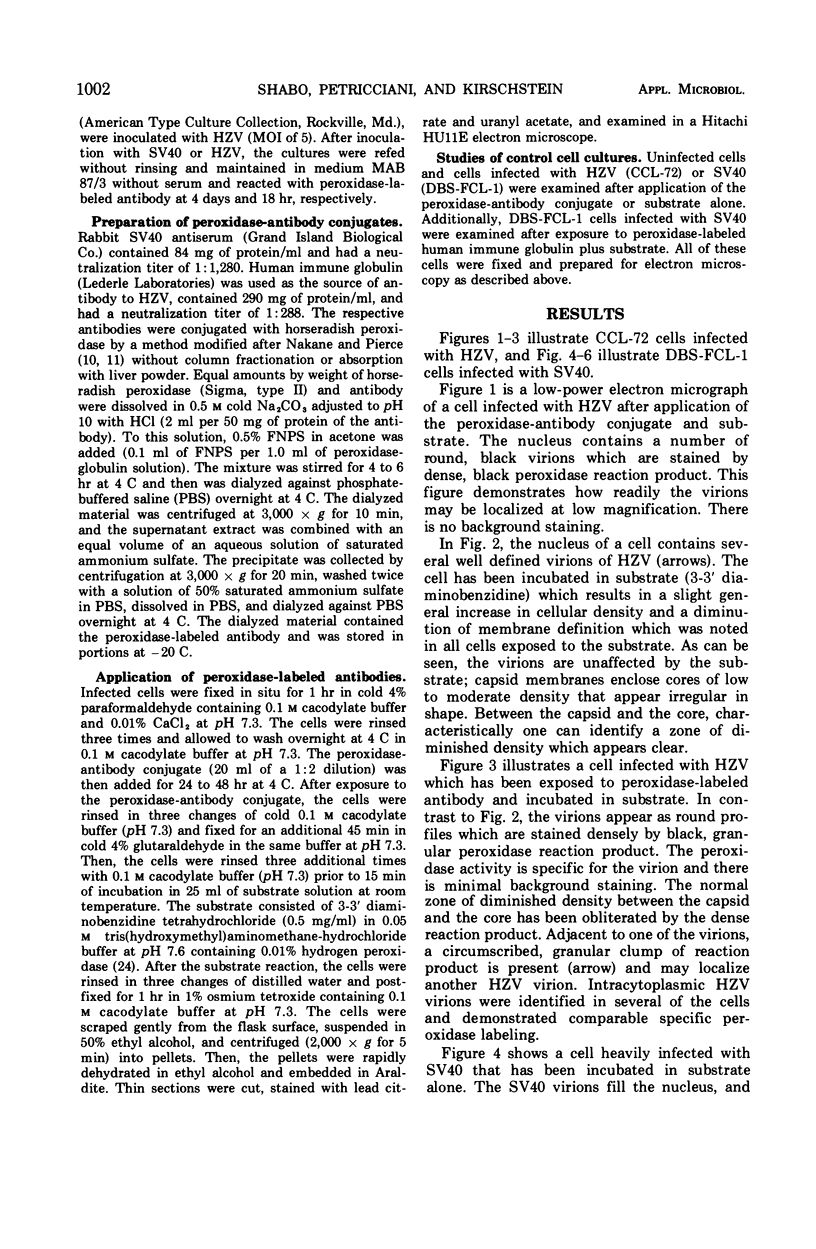
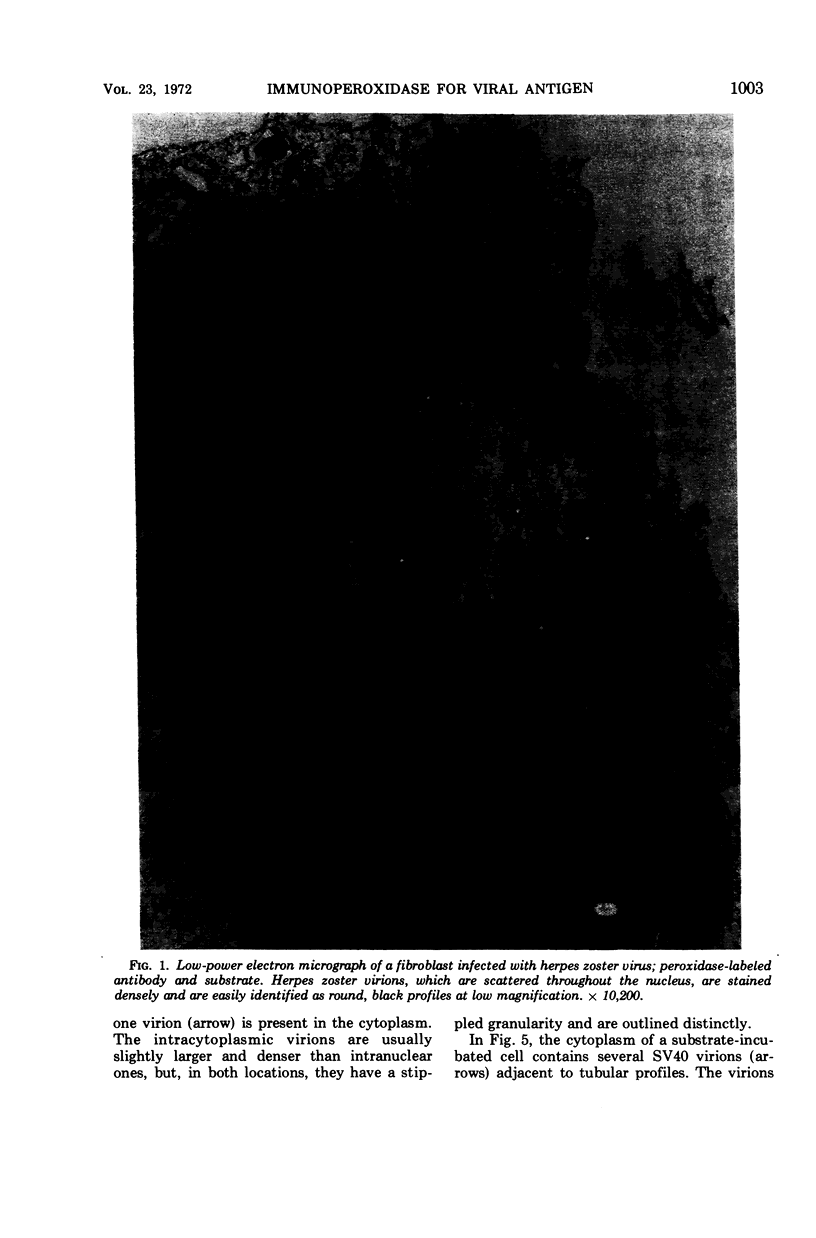
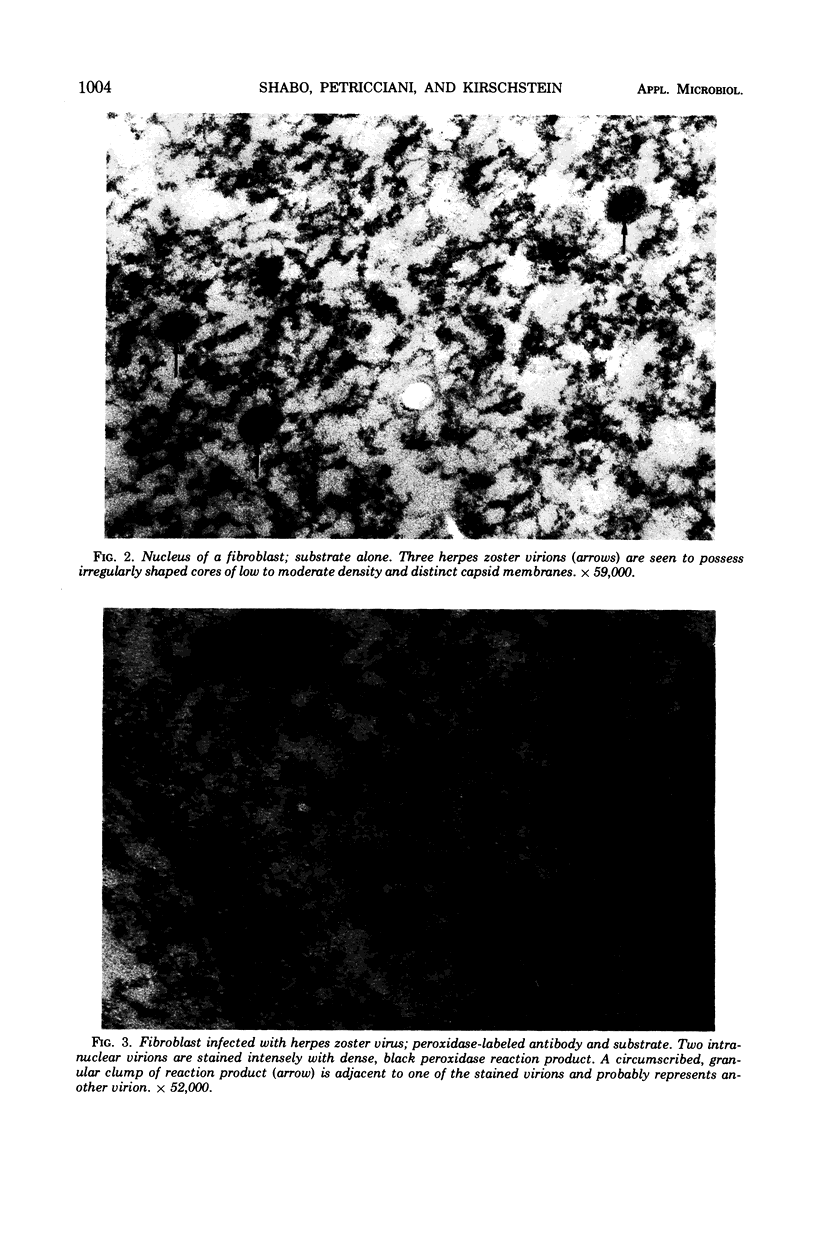
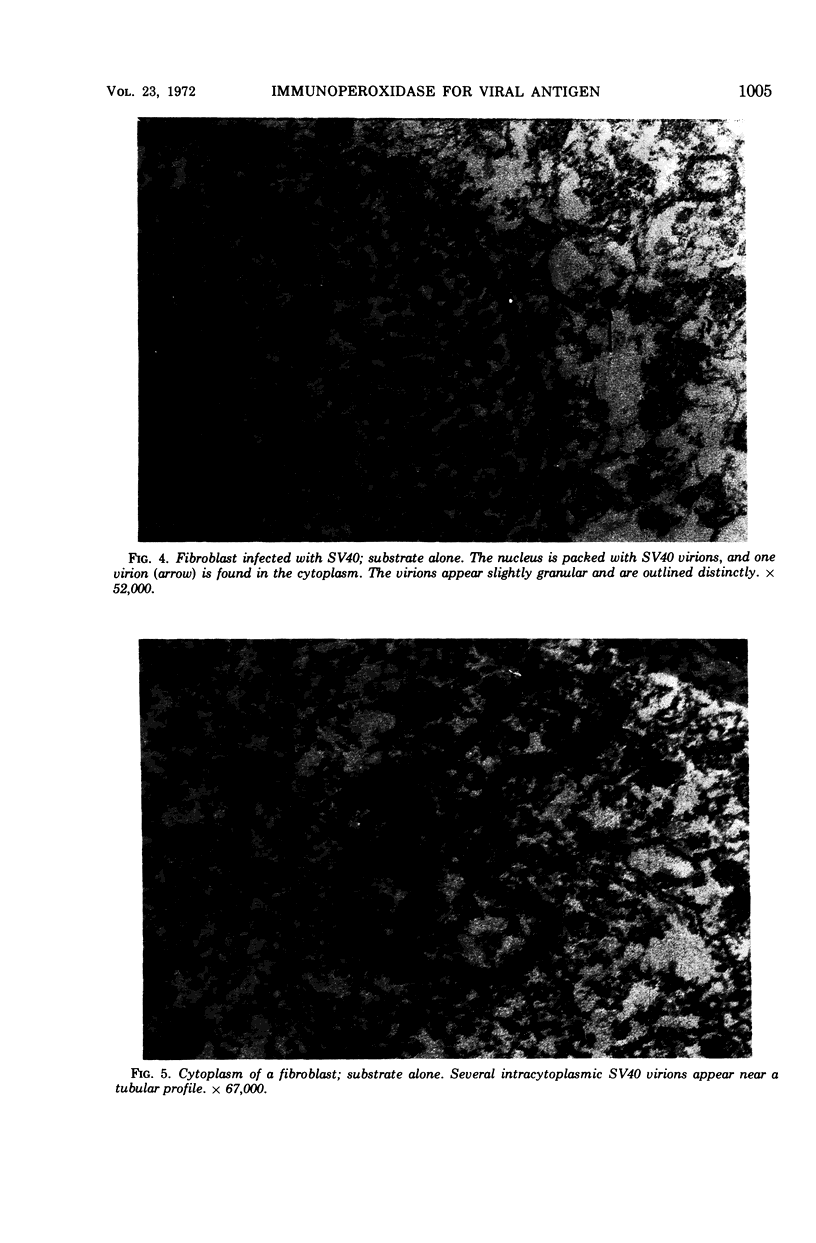
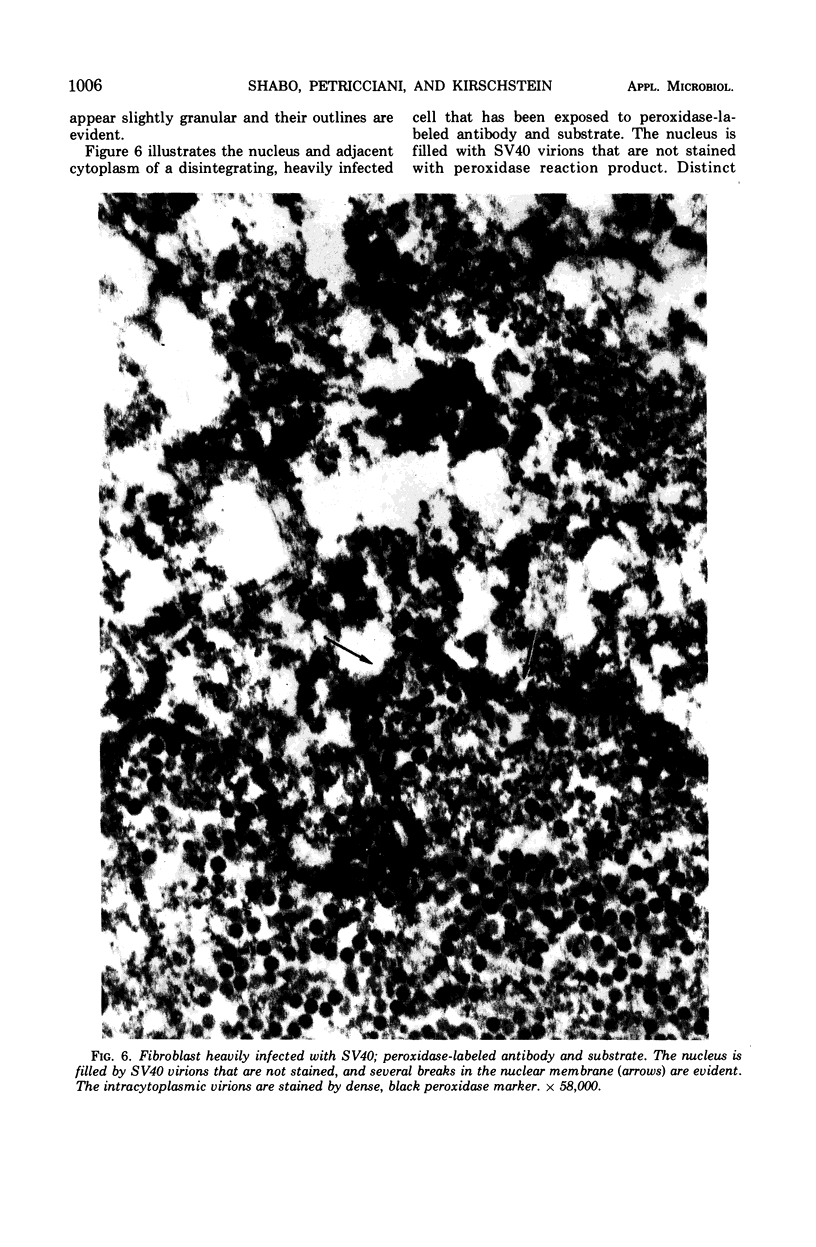
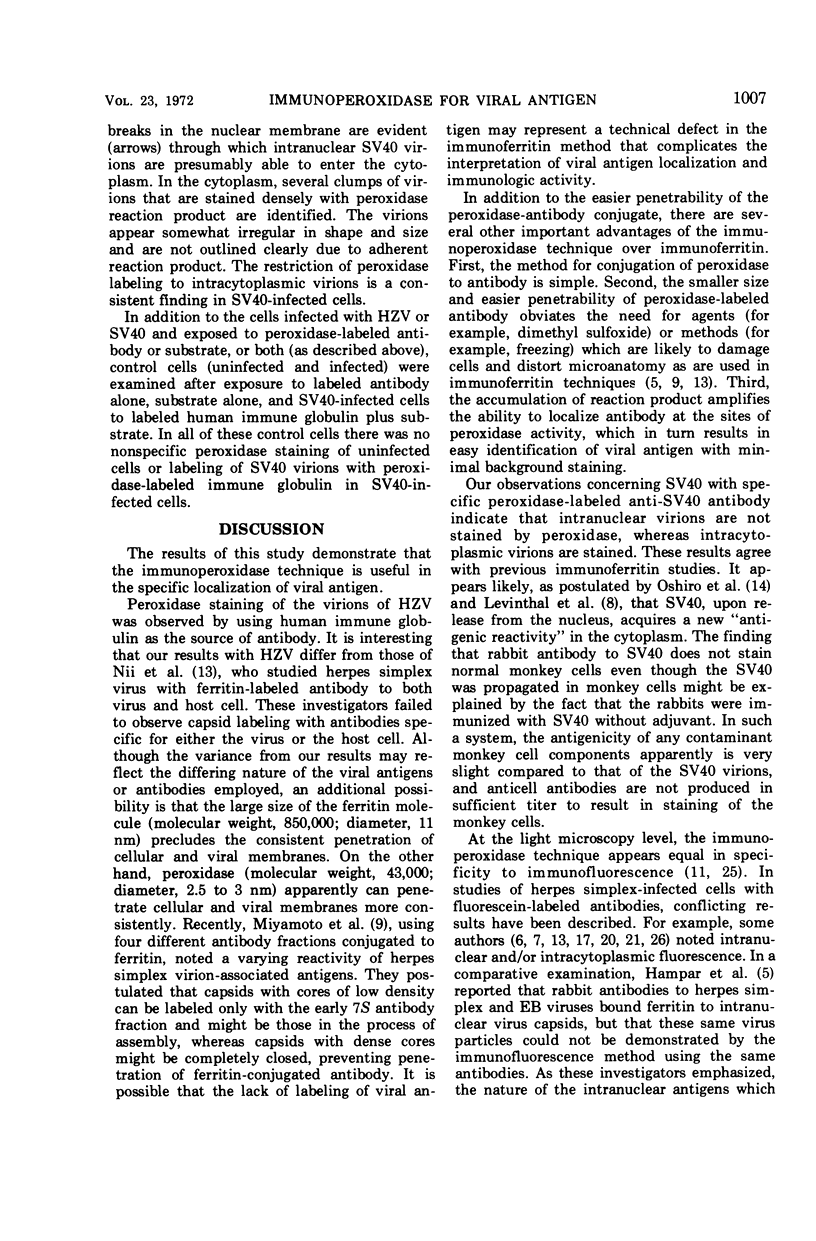
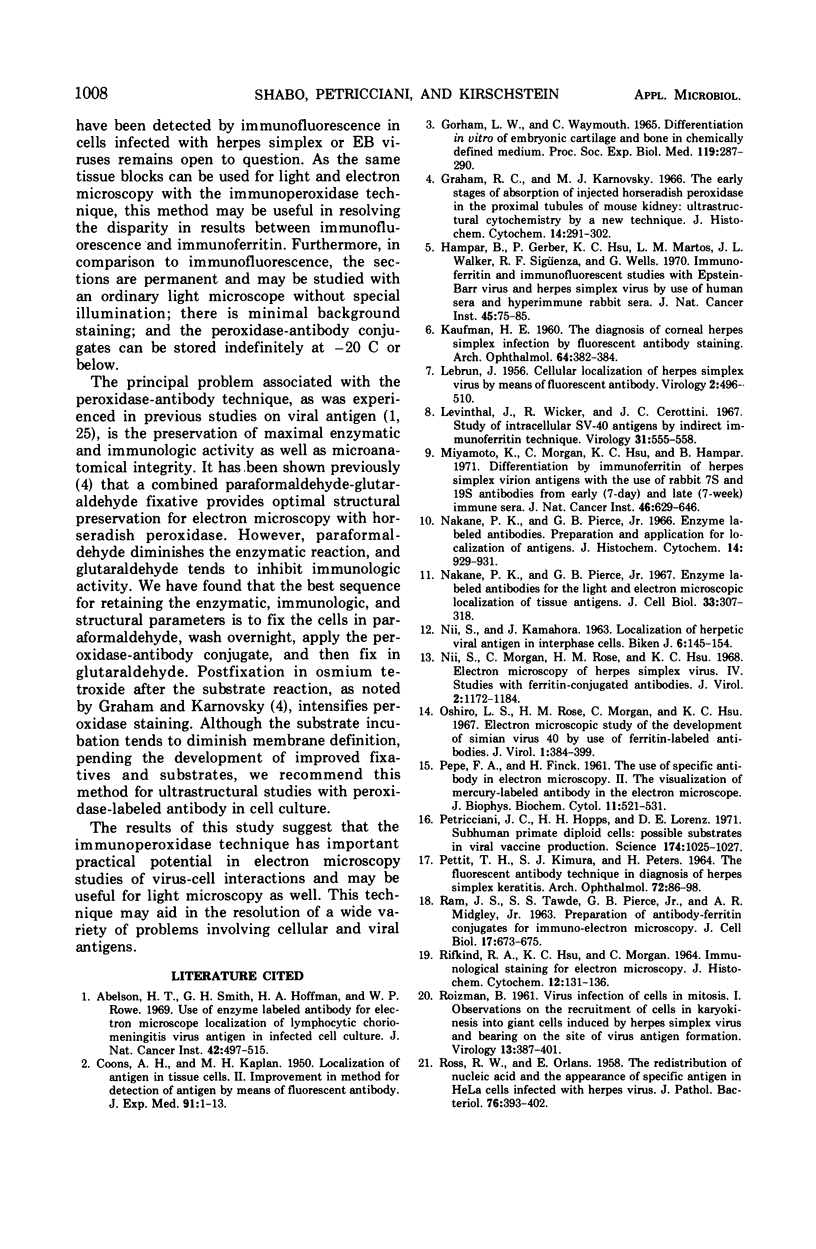

Images in this article
Selected References
These references are in PubMed. This may not be the complete list of references from this article.
- Abelson H. T., Smith G. H., Hoffman H. A., Rowe W. P. Use of enzyme-labeled antibody for electron microscope localization of lymphocytic choriomeningitis virus antigens in infected cell cultures. J Natl Cancer Inst. 1969 Mar;42(3):497–515. [PubMed] [Google Scholar]
- COONS A. H., KAPLAN M. H. Localization of antigen in tissue cells; improvements in a method for the detection of antigen by means of fluorescent antibody. J Exp Med. 1950 Jan 1;91(1):1–13. doi: 10.1084/jem.91.1.1. [DOI] [PMC free article] [PubMed] [Google Scholar]
- GORHAM L. W., WAYMOUTH C. DIFFERENTIATION IN VITRO OF EMBRYONIC CARTILAGE AND BONE IN A CHEMICALLY-DEFINED MEDIUM. Proc Soc Exp Biol Med. 1965 May;119:287–290. doi: 10.3181/00379727-119-30160. [DOI] [PubMed] [Google Scholar]
- Graham R. C., Jr, Karnovsky M. J. The early stages of absorption of injected horseradish peroxidase in the proximal tubules of mouse kidney: ultrastructural cytochemistry by a new technique. J Histochem Cytochem. 1966 Apr;14(4):291–302. doi: 10.1177/14.4.291. [DOI] [PubMed] [Google Scholar]
- Hampar B., Gerber P., Hsu K. C., Martos L. M., Walker J. L., Sigüenza R. F., Wells G. A. Immunoferritin and immunofluorescent studies with Epstein-Barr virus and herpes simplex virus by use of human sera and hyperimmune rabbit sera. J Natl Cancer Inst. 1970 Jul;45(1):75–85. [PubMed] [Google Scholar]
- KAUFMAN H. E. The diagnosis of corneal herpes simplex infection by fluorescent antibody staining. Arch Ophthalmol. 1960 Sep;64:382–384. doi: 10.1001/archopht.1960.01840010384009. [DOI] [PubMed] [Google Scholar]
- LEBRUN J. Cellular localization of Herpes simplex virus by means of fluorescent antibody. Virology. 1956 Aug;2(4):496–510. doi: 10.1016/0042-6822(56)90006-x. [DOI] [PubMed] [Google Scholar]
- Levinthal J. D., Wicker R., Cerottini J. C. Study of intracellular SV40 antigens by indirect immunoferritin technique. Virology. 1967 Mar;31(3):555–558. doi: 10.1016/0042-6822(67)90239-5. [DOI] [PubMed] [Google Scholar]
- Miyamoto K., Morgan C., Hsu K. C., Hampar B. Differentiation by immunoferritin of herpes simplex antigens with the use of rabbit 7S and 19S antibodies from early (7-day) and late (7-week) immune sera. J Natl Cancer Inst. 1971 Mar;46(3):629–646. [PubMed] [Google Scholar]
- NII S., KAMAHORA J. LOCATION OF HERPETIC VIRAL ANTIGEN IN INTERPHASE CELLS. Biken J. 1963 Jul;6:145–154. [PubMed] [Google Scholar]
- Nakane P K, Pierce G B., Jr Enzyme-labeled antibodies: preparation and application for the localization of antigens. J Histochem Cytochem. 1966 Dec;14(12):929–931. doi: 10.1177/14.12.929. [DOI] [PubMed] [Google Scholar]
- Nakane P. K., Pierce G. B., Jr Enzyme-labeled antibodies for the light and electron microscopic localization of tissue antigens. J Cell Biol. 1967 May;33(2):307–318. doi: 10.1083/jcb.33.2.307. [DOI] [PMC free article] [PubMed] [Google Scholar]
- Nii S., Morgan C., Rose H. M., Hsu K. C. Electron microscopy of herpes simplex virus. IV. Studies with ferritin-conjugated antibodies. J Virol. 1968 Oct;2(10):1172–1184. doi: 10.1128/jvi.2.10.1172-1184.1968. [DOI] [PMC free article] [PubMed] [Google Scholar]
- Oshiro L. S., Rose H. M., Morgan C., Hsu K. C. Electron microscopic study of the development of simian virus 40 by use of ferritin-labeled antibodies. J Virol. 1967 Apr;1(2):384–399. doi: 10.1128/jvi.1.2.384-399.1967. [DOI] [PMC free article] [PubMed] [Google Scholar]
- PEPE F. A., FINCK H. The use of specific antibody in electron microscopy. II. The visualization of mercury-labeled antibody in the electron microscope. J Biophys Biochem Cytol. 1961 Dec;11:521–531. doi: 10.1083/jcb.11.3.521. [DOI] [PMC free article] [PubMed] [Google Scholar]
- PETTIT T. H., KIMURA S. J., PETERS H. THE FLUORESCENT ANTIBODY TECHNIQUE IN DIAGNOSIS OF HERPES SIMPLEX KERATITIS. Arch Ophthalmol. 1964 Jul;72:86–98. doi: 10.1001/archopht.1964.00970020088020. [DOI] [PubMed] [Google Scholar]
- Petricciani J. C., Hopps H. E., Lorenz D. E. Subhuman primate diploid cells: possible substrates for production of virus vaccines. Science. 1971 Dec 3;174(4013):1025–1027. doi: 10.1126/science.174.4013.1025. [DOI] [PubMed] [Google Scholar]
- RIFKIND R. A., HSU K. C., MORGAN C. IMMUNOCHEMICAL STAINING FOR ELECTRON MICROSCOPY. J Histochem Cytochem. 1964 Feb;12:131–136. doi: 10.1177/12.2.131. [DOI] [PubMed] [Google Scholar]
- ROIZMAN B. Virus infection of cells in mitosis. I. Observations on the recruitment of cells in karyokinesis into giant cells induced by herpes simplex virus and bearing on the site of virus antigen formation. Virology. 1961 Apr;13:387–401. doi: 10.1016/0042-6822(61)90269-0. [DOI] [PubMed] [Google Scholar]
- ROSS R. W., ORLANS E. The redistribution of nucleic acid and the appearance of specific antigen in HeLa cells infected with herpes virus. J Pathol Bacteriol. 1958 Oct;76(2):393–402. doi: 10.1002/path.1700760208. [DOI] [PubMed] [Google Scholar]
- SINGER S. J. Preparation of an electron-dense antibody conjugate. Nature. 1959 May 30;183(4674):1523–1524. doi: 10.1038/1831523a0. [DOI] [PubMed] [Google Scholar]
- SRI RAM J., TAWDE S. S., PIERCE G. B., Jr, MIDGLEY A. R., Jr Preparation of antibody-ferritin conjugates for immunoelectron microscopy. J Cell Biol. 1963 Jun;17:673–675. doi: 10.1083/jcb.17.3.673. [DOI] [PMC free article] [PubMed] [Google Scholar]
- Takemoto K. K., Todaro G. J., Habel K. Recovery of SV40 virus with genetic markers of original inducing virus from SV40-transformed mouse cells. Virology. 1968 May;35(1):1–8. doi: 10.1016/0042-6822(68)90299-7. [DOI] [PubMed] [Google Scholar]
- Ubertini T., Wilkie B. N., Noronha F. Use of horseradish peroxidase-labeled antibody for light and electron microscope localization of reovirus antigen. Appl Microbiol. 1971 Mar;21(3):534–538. doi: 10.1128/am.21.3.534-538.1971. [DOI] [PMC free article] [PubMed] [Google Scholar]
- VOZZA R., BALDUCCI D. The technique of fluorescent antibodies in opthalmology. A study of herpes simplex and vaccine keratoconjunctivitis and human trachomatous infection. Am J Ophthalmol. 1961 Jul;52:72–77. [PubMed] [Google Scholar]



